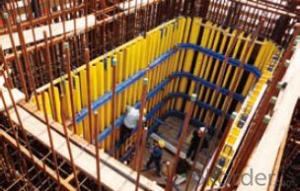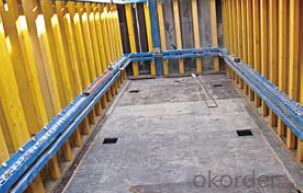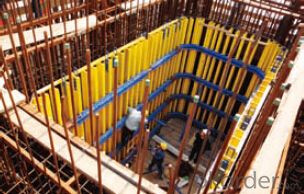Shaft Platform S40 System for Formwork and Scaffolding
- Loading Port:
- Tianjin
- Payment Terms:
- TT OR LC
- Min Order Qty:
- 50 m²
- Supply Capability:
- 1000 m²/month
OKorder Service Pledge
Quality Product, Order Online Tracking, Timely Delivery
OKorder Financial Service
Credit Rating, Credit Services, Credit Purchasing
You Might Also Like
Shaft Platform
As operating platform, the shaft platform is mainly used in the concrete pouring of elevator shaft,
equipment shaft, stair shaft of high-rise building and so on.
Characteristics:
◆ The length of shaft beam is adjustable.
◆ Flexible structure makes lifting easier.
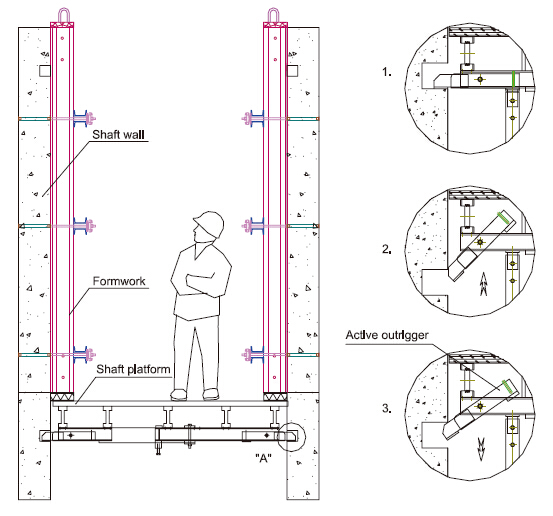
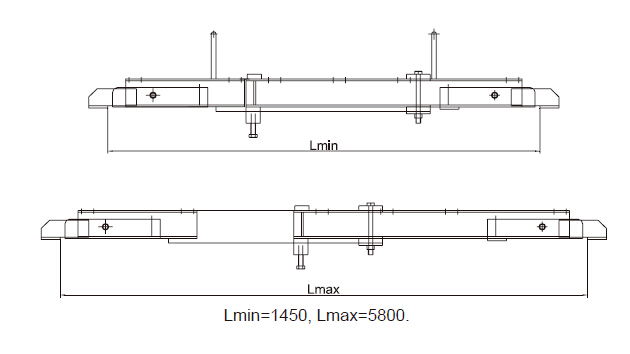
- Q: Can steel formwork be used for both horizontal and vertical concrete placement?
- Yes, steel formwork can be used for both horizontal and vertical concrete placement. Steel formwork is a versatile and durable solution for creating molds or frames that hold wet concrete in the desired shape until it sets and hardens. This type of formwork is commonly used in construction projects for various applications, including both horizontal and vertical concrete placement. Steel forms are strong enough to withstand the weight and pressure of the concrete, making them suitable for vertical applications such as walls, columns, and beams. Additionally, steel formwork can be easily adjusted or modified to accommodate different shapes and sizes, making it ideal for horizontal placements like slabs, floors, and pavement. Overall, steel formwork offers flexibility, strength, and stability, making it suitable for a wide range of concrete placement requirements.
- Q: How does steel formwork affect the overall acoustics of the building?
- Steel formwork can have a significant impact on the overall acoustics of a building. Due to its dense and rigid nature, steel formwork tends to reflect sound waves instead of absorbing them. This reflection can cause an increase in overall noise levels and create echoes within the building. The use of steel formwork can result in a higher reverberation time, which is the time it takes for sound to decay by 60 decibels. This can lead to poor speech intelligibility and reduced clarity of audio within the space. Additionally, the sound reflections from steel formwork can interfere with the natural acoustic properties of the room, potentially causing distortion and resonance issues. To address these challenges, sound-absorbing materials can be added to the interior surfaces of the building. This can help to reduce the reflection and reverberation of sound waves, improving the overall acoustics of the space. Options include the use of acoustic panels, insulation materials, and ceiling treatments that absorb and diffuse sound. It is important to consider the specific requirements of the building and its intended use when deciding on the type of formwork to be used. For spaces where good acoustics are crucial, such as auditoriums, concert halls, or recording studios, alternative formwork materials that provide better sound absorption properties may be preferred over steel formwork. However, in other applications where acoustics are less critical, steel formwork can still be used effectively with the addition of appropriate sound-absorbing measures. Overall, the choice of steel formwork can have a significant impact on the acoustics of a building. Proper consideration of sound absorption and reflection properties, along with the use of additional acoustic treatments, can help to mitigate any negative effects and create a more pleasant and functional acoustic environment.
- Q: What are the common quality control measures for steel formwork?
- Steel formwork undergoes several quality control measures to ensure its compliance with standards and specifications: 1. Thoroughly inspect the steel formwork for visible defects or damage, such as cracks, dents, or deformations, and address them accordingly. 2. Measure the dimensions of the steel formwork, including length, width, and height, and compare them to the specified requirements. Correct any deviations from the required dimensions. 3. Conduct material testing to verify that the steel formwork meets the necessary standards and specifications. This includes testing its tensile strength, yield strength, hardness, and chemical composition. 4. Inspect the quality of welds if the steel formwork is welded. Check for proper penetration, fusion, and the absence of defects like cracks or porosity. Employ non-destructive testing methods like ultrasonic or radiographic testing to ensure the integrity of the welds. 5. Inspect the surface coating, such as paint or galvanized coating, for thickness, adhesion, and uniformity. This guarantees protection against corrosion and enhances the durability of the formwork. 6. Subject the steel formwork to load testing to evaluate its structural integrity and load-bearing capacity. Apply a known load and monitor the formwork's response to ensure it can safely support the required loads during construction. 7. Document and maintain records of the quality control measures for future reference. This includes recording inspection results, material test reports, and any corrective actions taken. By implementing these quality control measures, the steel formwork can meet the necessary standards, specifications, and safety regulations, ensuring its structural integrity and performance during construction.
- Q: How does steel formwork contribute to the fire resistance of the structure?
- Steel formwork does not directly contribute to the fire resistance of a structure. Its main purpose is to provide temporary support during the construction process. However, steel formwork can indirectly contribute to fire resistance by ensuring the proper placement and alignment of concrete, which is a fire-resistant material. The correct installation of concrete using steel formwork can help create a structurally sound and fire-resistant building.
- Q: Is steel formwork suitable for all types of concrete structures?
- No, steel formwork may not be suitable for all types of concrete structures. While steel formwork is versatile and durable, it may not be cost-effective or practical for smaller projects or structures with complex designs. Additionally, certain conditions such as extreme temperatures, corrosive environments, or high-rise buildings may require alternative formwork systems. Therefore, the suitability of steel formwork depends on the specific project requirements and considerations.
- Q: How does steel formwork handle concrete curing additives?
- Steel formwork is highly resistant to the chemical reactions caused by concrete curing additives. It can withstand the corrosive effects of these additives, ensuring the structural integrity of the formwork during the curing process.
- Q: What are the common design considerations for steel formwork in tunnel construction?
- Some common design considerations for steel formwork in tunnel construction include the strength and stability of the formwork, the ability to withstand the pressure of the surrounding soil or rock, the ease of installation and removal, the compatibility with other construction materials and techniques, and the potential for reuse or recycling. Additionally, considerations such as cost, safety, and environmental impact may also play a role in the design process.
- Q: How does steel formwork compare to timber formwork in terms of cost?
- Steel formwork generally tends to be more expensive than timber formwork in terms of upfront costs. This is primarily due to the higher cost of steel as compared to timber. Additionally, steel formwork often requires specialized equipment and skilled labor for assembly and disassembly, which can add to the overall cost. However, it is important to consider the long-term benefits and cost-effectiveness of steel formwork. While timber formwork may have a lower initial cost, it is more susceptible to wear and tear, especially in harsh weather conditions or when used repeatedly. Steel formwork, on the other hand, is highly durable and can be used for multiple construction projects, making it a cost-effective choice in the long run. Moreover, steel formwork offers greater precision and accuracy, resulting in better quality finishes and reduced rework. It also allows for faster construction due to its ease of assembly and disassembly, which can lead to significant time and labor savings, ultimately offsetting the higher upfront cost. In summary, while steel formwork may be more expensive initially, it offers durability, reusability, and higher productivity, making it a more cost-effective option in the long term compared to timber formwork.
- Q: Can steel formwork be used for water retaining structures?
- Yes, steel formwork can be used for water retaining structures. Steel formwork is known for its strength, durability, and ability to withstand high pressures. When properly designed and constructed, steel formwork can provide a watertight seal and effectively resist the hydrostatic pressure exerted by water. Additionally, steel formwork allows for a smooth and uniform finish, reducing the risk of water leakage. However, it is essential to ensure proper waterproofing measures are in place, such as using appropriate sealing materials and techniques, to prevent any potential water leakage or seepage through joints or connections. Regular inspection and maintenance are also necessary to ensure the long-term integrity of the water retaining structure.
- Q: How does steel formwork affect the overall quality of the concrete structure?
- Steel formwork plays a crucial role in determining the overall quality of a concrete structure. It affects the quality in several ways: 1. Dimensional Accuracy: Steel formwork ensures precise and accurate dimensions of the concrete structure. It provides a rigid framework that holds the concrete in shape during the pouring and curing process, preventing any deformation or distortion. This accuracy in dimensions contributes to the overall strength, stability, and durability of the structure. 2. Surface Finish: Steel formwork helps achieve a smooth and uniform surface finish of the concrete. The smoothness of the formwork translates into a smooth concrete surface, reducing the need for additional finishing work. A smooth surface not only enhances the aesthetic appeal but also improves the durability and resistance to wear and tear. 3. Strength and Load-bearing Capacity: Steel formwork is known for its high strength and load-bearing capacity. This strength allows it to withstand the pressure exerted by the concrete during pouring and curing. A sturdy formwork ensures that the concrete structure is adequately supported and can withstand the loads it is designed to bear. This contributes to the overall structural integrity and safety of the building. 4. Reusability and Cost-effectiveness: Steel formwork is reusable, making it a cost-effective option in the long run. Its durability allows it to withstand multiple uses, reducing the need for frequent replacements. This not only saves money but also reduces waste generated during construction. By using steel formwork, contractors can achieve high-quality concrete structures without compromising on cost or environmental impact. In conclusion, steel formwork greatly influences the overall quality of a concrete structure by providing dimensional accuracy, smooth surface finish, strength, load-bearing capacity, reusability, and cost-effectiveness. Its proper use ensures that the structure meets the required standards, enhances its durability, and ensures the safety of occupants.
Send your message to us
Shaft Platform S40 System for Formwork and Scaffolding
- Loading Port:
- Tianjin
- Payment Terms:
- TT OR LC
- Min Order Qty:
- 50 m²
- Supply Capability:
- 1000 m²/month
OKorder Service Pledge
Quality Product, Order Online Tracking, Timely Delivery
OKorder Financial Service
Credit Rating, Credit Services, Credit Purchasing
Similar products
Hot products
Hot Searches
Related keywords

